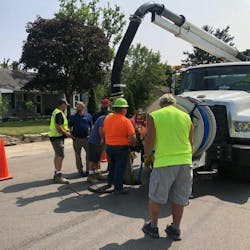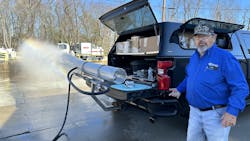Busting myths around sewer maintenance and cleaning
Sewer maintenance is an ongoing expense. Maintenance is a recurring challenge and, for cities and municipalities, a lack of training can be costly.
Missing best practice training can take an unncesary toll on public works departments’ time and expenses. It can increase labor, water and energy costs.
To help resolve best practice training gaps Dan Story, an operations manager and national trainer at KEG Technologies, conducts training classes across North America.
In his training classes Story often first addresses a common misconception: quickly running sewer line hoses up the line to effectively remove debris can be counterproductive.
Current practices can often contradict advancements in hose nozzle technologies. The “hurry up and clean” approach can potentially redirect sewage flow into homes.
For years, sewer maintenance crews have been taught to shoot a nozzle up a line in a hurry and clean as they come back. But this is not a race. If crews are not slowing down to cover all the ground, it simply is not going to work very well.
Instead Story trains sewer crews to clean as they go in and rinse as they come out. With this approach, crews can clean a line in one pass 95% of the time, instead of needing to make several passes.
For Story, who travels across the United States and Canada conducting training on sewer cleaning techniques, misconceptions abound in the industry and often reflect a lack of understanding of the fluid dynamics of high pressure nozzles. Over time, additional best practices have been developed through a process of trial and error.
As part of his training sessions, Story provides the following additional tips for sewage line cleaning.
Read the sewer line during cleaning
Sewer maintenance crews can learn a lot by paying attention to what is happening in the line going in and coming back.
“Crews need to be trained to understand what they are ‘reading’ coming out of the pipe,” said Story. “The information can tell you whether you are going too fast or too slow, how much debris is in the line, and whether the line is clean after the first pass – or not.”
When going up the line, for example, it is beneficial to observe the amount of debris present.
If there is minimal debris returning, that indicates the pipe is in relatively good condition, with a low accumulation of debris. So, cleaners can accelerate their speed. However, an excessive amount of recovered material should caution the cleaner to slow down. With a slower cleaning, the flow of water acts like a conveyor belt gently carrying the debris out.
When the water flow confirms the pipe has been cleaned at the right speed, the maintenance crew can then lower the pressure in the hose to between 900 and 1,000 PSI and come back through the pipe at the same speed. This final single pass can leave the line totally clean.
“The trick is paying attention to your hose,” said Story. “Make sure your hose comes back clean, and then you know your pipe is clean. How much debris is in the first pass? This information can tell you whether you’re going too fast or too slow. Remember to never outrun your flow because your flow is your conveyor belt. If there is a lot of material on the hose, it is telling me to slow down.”
Another common sewer cleaning misconception is that crews don’t need to open the upstream utility maintenance hole. This can actually increase pressure in the system and lead to blown toilets, where sewer gases flow up the laterals and cause sewage water to overflow from residential toilets.
According to Story, approximately 95% of blown toilets can be attributed to how the operator cleans the lines. However, identifying certain signs can help mitigate these issues. For instance, a sudden rush of water during the return flow could indicate the upstream utility maintenance hole was closed instead of being left open.
This ties back into the importance of paying attention and “reading” what is coming out of the pipe. Slowing down and observing the results allows for cleaning to be performed in a single pass, which helps safeguard the hose from potential damage.
Cleaning effectively can also maximize other assets’ lifespans. Going into each pipe once to clean it, rather than three times, basically triples the life of a three to four thousand dollar hose.
Beyond the wear and tear on the equipment there are also operational costs to consider such as water, fuel, as well as the productivity of the operators.
Cleaning more efficiently means lowering the operating costs per pipe and increasing what a city’s public works department can do.
Nozzle selection matters
Departments should not overlook the importance of nozzles even when expensive trucks are purchased for providing a water supply.
While a department may have invested a half-million dollars for a truck to clean sewer lines, its impact is only as good as the nozzle at the end of the hose.
There are tiers of nozzles which are rated for water efficiency from Tier 1 (about 30% efficient), Tier 2 (50-60% efficient), to Tier 3 (75-98% efficient).
However, even within the Tier 3 category, there are significant differences in levels of efficiency. Opting for the lower end Tier 3 nozzle with 75% efficiency could still lead to additional trips to refill. Also, such units may not remove restrictive sewer buildup or blockage in a timely manner.
A Tier-1, 30-degree drilled nozzle running 72 gallons a minute at 2,200 PSI will only exert 13 pounds of force to move debris nine feet away from the nozzle. In contrast, a very high-efficiency Tier-3 nozzle running 60 gallons a minute at 2,000 PSI will impact that plate nine feet away with 98 pounds of force. The right nozzle can make a significant difference in cleaning efficiency.
Use the right cleaning technique
Effective cleaning involves more than just using a powerful nozzle. It also entails understanding the proper positioning and placement of the nozzle within the pipe.
“We teach about the difference between laying a nozzle on the bottom of the pipe and centering it into the pipe,” said Story. “We teach about the flows and angles based on the size of the pipe — and the condition of the pipe based on the last camera footage.”
KEG trainers teach how to use a banked turn with the water hose to get more power with less water.
When a sewer line has an issue with roots or heavy grease, a controlled rotation nuozzle will cut and chop it enough to avoid creating downstream blockages. The best approach is using a nozzle capable of breaking up blockages to a particulate size small enough to go all the way to the treatment plant without creating a problem downstream.
The science behind best practices
With the advancement of nozzle technologies, there is a need for municipalities to get everyone on the same page about the proper techniques for cleaning sewer lines.
“What surprises even experienced sewer and storm professionals is the science that is behind the best practices,” said Story. “What we teach is based on understanding fluid dynamics. We look at the horsepower of your truck that drives the water pump for a rate of volume at a particular PSI level. We factor in the efficiency of the nozzle. What we want to get to is how to run the truck at a lot lower RPM and PSI that will clean the line easier, better and more efficiently.”
About the Author
Dan Story
Dan Story is an operations manager and national trainer at KEG Technologies. Story conducts sewer maintenance and cleaning training courses across North America.


